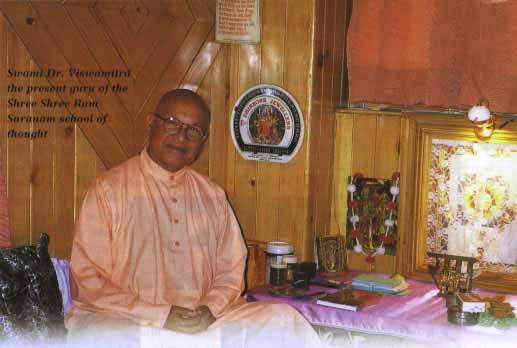THE CELESTIAL
SOUND OF RAM NAAM
Dr.
Gautam Chatterjee
(article
published in Discover India, Sep.'1999 issue.)
Explaining the mysticism of Shree
Shree Ram Sharnam, Swami Dr. Vishwamitter
Ji Maharaj explained in an exclusive interview with Discover
India at Manali.

In Manualaya, the land of God and
sages, lies Shree Shree Ram Sharnam Ashram. It stands amidst a tranquil
environ of apple orchards that are laden with fruit throughout the year.
Swami Satyanand
Saraswati was born in 1861 on Shukla Purnima (full moon day) in
Rawalpindi (modern Pakistan). Before long, he lost his parents and he
was brought up by his uncle. By the time he was 17, he got the
opportunity to interact with Jain Munis. Empowered with a sharp memory
and dedication, he mastered the literary brought him name and fame. But,
with the passage of time, he decided to move on and so he entered the
Arya Samaj which preached the Vedas.
There after he preached the
philosophy of 'Ram', the eternal sound, so that the common man could get
an attainable spiritual direction without dogmas or ritualistic worship.
Today, this sacred name besmears millions around the world under the
auspicious banner of 'Shree Shree Ram Saharnam' which literally means
'taking refuge in Ram'.
Swami Satyanand Saraswtai propounds the
theory of Naam Japa (reciting a name) on a scientific line
of 'sound' phenomenon within and outside every human being. He looked into
it more as a 'research scientist' of name theosophy where the end result
remains a matter of 'experiencing' the bliss and living through it to
attain enlightenment. There are no rituals or dogmas. The central theme is
worshipping the name of Ram and the utterance is the method of attainment
of enlightenment.
In the doctrine of Naam Yoga
one has to install the celestial sound in one's heart as the 'sound idol'.
Though the process of loud and silent chanting within it envelops the mind
and body. Then it works as a system of 'theosophical medication' curing
ailments caused by chaos within and restores peace and tranquillity.
In the Shree Shree Ram Sharnam school of
thought the name of Ram a certain number of times is not prescribed as a
108 or 1001 which is prevalent in other systems. Rather, one may chant the
name as many times as possible even while working. And then there is the
concept of Ajapa Jaap. This is a state of mind where
internally the name continues to resound even when one is in deep sleep.
Chanting name an unlimited number of times leads to creation of 'sacred
space' which throws away the 'evil' of the mind and body thus purifyng the
soul. This is a method of 'sound' bathing. The sound 'Ram' works as a
creative sonic energy within and wipes out human weaknesses to strive for
the attainment of enlightenment.
Swami Satyanand attained parinirvana
on November 13, 1960. Thereafter, a close disciple, Premji
Maharaj, a homoeopath and spiritual healer, took the lead to expand
the philosophy of Naam Daan. After him,
the trust appointed Dr. Vishwamitter Ji Maharaj,
a renowned ocular micro-biologist who has 22 years of service at the All
India Medical Sciences in Delhi.
Explaining the mysticism of Shree Shree Ram
Sharnam, Swami Dr. Vishwamitter explained in an exclusive interview with
Discover India at Manali that there are three primary Ss in Naam
Japa:
Simran - taking the name of
the Lord ceaselessly. Through this process the attributes of Lord Rama
Besmear the soul. Thus Rama dwells in the heart of the devout.
The second 'S' is samyam
(self control) which develops ethical and moral refinement.
And the last 'S' is sewa
(service). This service dies not mean donation of money or offering
one's service but service to God by means of japa (counting the beads)
and praying for others. Thus Shree Shree Ram Sharnam also propounds the
theory of Vasudhaiva Kutumbakam (the whole world is one
family).